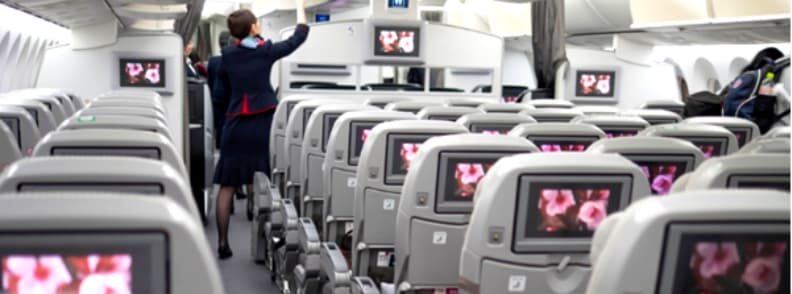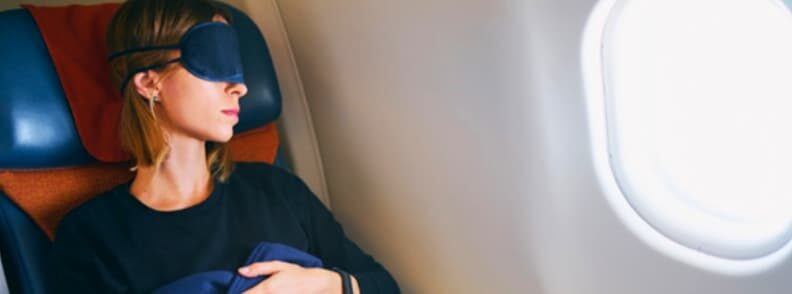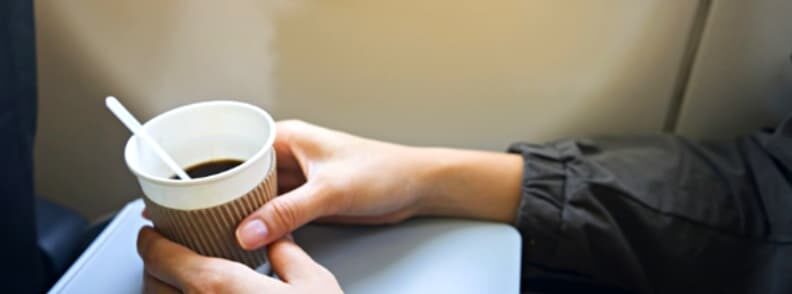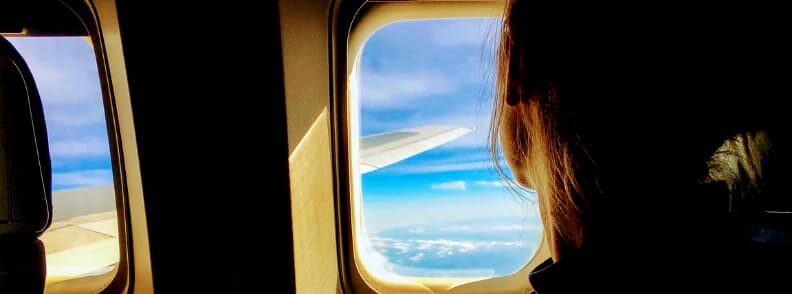Nothing can ruin the excitement of traveling quite like jet lag. Uncomfortable seats, limited legroom, noisy neighbors, and turbulence can make falling asleep on a plane feel impossible.
If you often struggle to get a decent amount of shuteye while flying, you’re not alone. Plenty of travelers experience jet lag, but making some simple changes to your flying habits can help reduce the effects of sleep deprivation.
Consider these tips to land at your destination feeling well-rested and ready to make the most of your trip away.
Why is it hard to sleep on a plane?
There are a few reasons why it can be challenging to get quality sleep on a plane. Firstly, the environment is far from ideal, with cramped seating, constant noise, and bright lights that can disrupt natural sleep patterns. Additionally, the air pressure and humidity levels on a plane can cause dehydration and discomfort, which can make it harder to relax and fall asleep. Finally, the time zone changes associated with long-haul flights can throw off your circadian rhythm and make it difficult to fall asleep at the right time. All of these factors can make it a real challenge to get the rest you need on a plane, which is why it’s essential to have some strategies in place to help you sleep better.
The importance of getting sleep on a plane
As an experienced traveler, I know that getting a good night’s sleep on a plane can be a real challenge. However, it’s essential to make the most of your journey and arrive at your destination feeling refreshed and ready to go. Whether you’re a frequent flyer, business traveler, or globetrotter embarking on a once-in-a-lifetime adventure, you’ll want to know the best tips and tricks for sleeping on a plane.
But why is it so important to sleep on a plane? Well, for starters, getting a good night’s sleep helps you combat the effects of jet lag, which can leave you feeling disoriented, fatigued, and generally out of sorts. Jet lag occurs when your body’s natural circadian rhythms are disrupted, usually due to crossing multiple time zones in a short period.
To beat jet lag and get the sleep you need, it’s essential to have a plan of action. In this article, we’ll cover all the tips and tricks you need to know to get a good night’s sleep on a plane, including choosing the right seat, packing essential sleep accessories, and creating a comfortable sleeping environment. We’ll also share our top tips for beating jet lag, including how to adjust to a new time zone and the role of exercise in combating jet lag.
So, whether you’re a seasoned traveler or embarking on your first long-haul flight, read on for our expert advice on how to sleep on a plane. By the end of this article, you’ll have all the tools you need to arrive at your destination feeling well-rested, refreshed, and ready to take on the world.
Pre-flight tips to sleep on a plane
When it comes to getting a good night’s sleep on a plane, pre-flight preparation is key. By taking a few simple steps before you board, you can set yourself up for a more restful flight and a better chance of beating jet lag. Here are my top pre-flight tips for sleeping on a plane:

1. Choose your flight and seat carefully
Catching a long-haul flight first thing in the morning can add to that disoriented feeling associated with jet lag. You probably won’t feel like sleeping, and the bright sunshine streaming through the plane’s windows will make it more difficult to turn your brain off. Book a red-eye flight so you’ll be ready to fall asleep as soon as you take off.
Seat selection is another important consideration for beating jet lag. Sitting on the aisle offers some benefits, but beware of being the gatekeeper to the plane’s bathroom. Other passengers in your row will probably need to use the toilet eventually, especially on long-haul flights. Just imagine the frustration of finally falling asleep, only to be woken a few minutes later by a timid tap on the shoulder.
To enjoy hours of continuous shuteye, do your best to book a window seat. You won’t have to deal with as many interruptions, and you can use the wall of the plane for support while sleeping.
If you’re hoping to catch some shut-eye during your flight, avoid seats near the galley, restrooms, or engines, as they can be noisy and disruptive. Opt for a window seat in the front row of the plane to have more legroom (although these seats often cost more). This will provide a more comfortable and private sleeping environment.

2. Pack essential sleep accessories
Boarding a flight with nothing but your passport and plane ticket makes you more vulnerable to jet lag. There’s no need to fill your entire carry-on case with sleep aides, but a few essential items can make a world of difference to your comfort levels.
Packing essential sleep accessories can make a big difference. Invest in a high-quality neck pillow, which will help support your head and prevent neck strain. Earplugs or noise-canceling headphones can help block out any ambient noise, while an eye mask will help create a dark sleeping environment. Additionally, consider packing a lightweight blanket or sweater to keep you warm during your flight.
Distractions are inevitable on planes, but being able to block out the worst of the noise and bright lights can help put you in the right frame of mind for sleep.
A good book and relaxing music may also help you sleep on a plane.

3. Avoid certain food and drinks
Eating and drinking habits before flying can also impact your ability to sleep. Avoid heavy, fatty meals, which can cause indigestion and make it difficult to sleep. Instead, opt for light, healthy snacks like fruits, vegetables, and nuts, which can help you feel more energized and alert. Hydration is also important, so make sure to drink plenty of water before and during your flight.
Caffeine is the nemesis of sleep, so try to avoid coffee and energy drinks before boarding a long-haul flight. Even if you need to get up at dawn to make your flight on time, try and resist the lure of a good latte. No matter how hard you try, you won’t be able to sleep with caffeine coursing through your veins.
Try herbal tea instead, or just stick with water if you want to sleep on a plane easily. Flying can be very dehydrating, so it’s important to keep your fluids up. Avoiding alcohol can also help with your quality of sleep on a plane, as you won’t have to arrive at your destination with a hangover.

4. Get a good night’s sleep
Getting plenty of rest prior to flying overseas is key to beating jet lag. Try and contain your pre-holiday excitement and go to bed early the night before your flight departs. Don’t attempt to tire yourself out so you’ll sleep on the plane – this can backfire and make your jet lag even worse.
No matter how much you manage to sleep during your flight, landing in a new time zone is bound to mess with your body clock. Jet lag is an integral part of international travel, so don’t feel bad if you arrive at your destination feeling a little worse for wear. Simply take a nap then get on with your travels!
Get a good night’s sleep on an ultra-comfortable mattress from Sleepy’s.
5. Practice relaxation techniques
Relaxation techniques can be a powerful tool for promoting sleep on a plane. Try practicing deep breathing exercises or mindfulness meditation before boarding to help calm your mind and reduce anxiety. You can also consider using a relaxation app or listening to soothing music to help you drift off.
In-flight tips to sleep on a plane
Now that you’ve taken steps to prepare for sleep on your flight, it’s time to focus on in-flight tips to help you get some shut-eye. Follow these tips to create a comfortable sleeping environment and minimize disruptions:
1. Create a comfortable environment
Creating a comfortable sleeping environment on a plane is crucial for getting a good night’s sleep. With a few simple steps, you can turn your seat into a cozy and inviting sleeping space.
Firstly, adjust your seat to a reclined position and use a neck pillow for added support. If you have a window seat, lean against the wall for added comfort. You can also use a small pillow or rolled-up blanket to support your lower back or hips, especially if you have lower back pain.
Next, consider using a blanket or sweater to create a cozy sleeping environment. Most airlines provide blankets, but they can be thin and scratchy. Consider bringing your own soft blanket or sweater to help regulate your body temperature and create a sense of comfort and security.
If you’re sensitive to light, consider using an eye mask to block out light and create a dark sleeping environment. You can also use a scarf or a sweater to cover your eyes if you don’t have an eye mask. Earplugs or noise-canceling headphones can also help block out ambient noise and create a more peaceful sleeping environment.
Finally, try to create a calm and relaxing atmosphere by listening to soothing music or meditating. Many airlines offer in-flight entertainment systems with relaxation or meditation programs that you can use to help you fall asleep. Alternatively, you can download your own relaxation music or guided meditation programs to listen to on your phone or tablet.
Creating a comfortable sleeping environment on a plane is all about using the resources available to you and taking a few extra steps to make yourself feel at home.
2. Find the right sleeping position on a plane
Finding the right sleeping position on a plane can be challenging, but it’s essential for getting quality sleep. Here are some tips to help you find the right position:
- Back sleepers. If you’re a back sleeper, recline your seat and place a lumbar pillow or rolled-up blanket behind your lower back to maintain the natural curve of your spine. Use a neck pillow to support your head and neck, and keep your arms at your sides or across your chest.
- Side sleepers. Side sleepers should use a pillow between their knees to align their spine and reduce pressure points. Place a neck pillow under your head to maintain a neutral position and keep your arms at your sides or across your chest.
- Stomach sleepers. Sleeping on your stomach is not recommended on a plane as it can strain your neck and back, even if you have a seat that can completely turn into a bed. However, if you must, use a thin pillow under your head to avoid neck strain and keep your arms at your sides or across your chest.
- Hybrid sleepers. If you’re a combination sleeper, try to find a position that is comfortable and supportive for all parts of your body. Experiment with different pillow placements and arm positions to find the best position for you.
Remember to adjust your seat and use pillows and blankets to create a comfortable sleeping environment. Also, try to avoid crossing your legs, as this can restrict blood flow and cause discomfort. With a little bit of experimentation, you’ll be able to find the right sleeping position on a plane and get the restful sleep you need.
3. Minimize noise and light disturbance to sleep on a plane
Minimizing noise and light disturbance is crucial for getting quality sleep on a plane, especially if you’re traveling on a long-haul flight. A few simple steps can make a big difference in creating a peaceful sleeping environment.
First, consider using noise-canceling headphones or earplugs to block out ambient noise. These are especially helpful if you’re seated near the engines or in a noisy part of the plane. Alternatively, you can use a white noise app or a machine to mask background noise and help you drift off to sleep.
Next, an eye mask can help create a dark sleeping environment. Most airlines provide them on long-haul flights, but you can also bring your own if you prefer. Look for an eye mask that’s comfortable and adjustable, and consider one that has molded eye cups to prevent pressure on your eyes.
If you don’t have an eye mask, you can still minimize light disturbance by using a scarf or sweater to cover your eyes. Simply drape it over your forehead and eyes to create a makeshift eye mask.
Another way to minimize light disturbance is to choose a window seat and close the window shade. This will block out natural light and help you create a darker sleeping environment. If you’re seated in an aisle or middle seat, ask your seatmate to lower their shade if possible.
Minimizing noise and light disturbance is key to getting quality sleep on a plane. By using noise-canceling headphones or earplugs, an eye mask or makeshift covering, and closing your window shade, you can create a peaceful sleeping environment and wake up feeling refreshed upon arrival.
4. Regulate your body temperature
Regulating your body temperature is a crucial aspect of getting good quality sleep on a plane. The temperature in an airplane cabin can be unpredictable and can vary significantly throughout the flight. To regulate your body temperature, dress in comfortable, breathable clothing that is easy to layer. This way, you can add or remove layers as needed to maintain a comfortable body temperature.
If you tend to get cold easily, consider bringing a blanket or wearing a sweater. Many airlines offer blankets on long-haul flights, but they may not be enough to keep you warm if you’re sensitive to the cold. Bringing your own blanket or sweater can ensure that you stay warm and cozy throughout the flight.
On the other hand, if you tend to get warm easily, consider dressing in layers that can be easily removed. This way, you can adjust your clothing to prevent overheating. Additionally, you can use the air conditioning vent above your seat to adjust the flow of cool air.
It’s also important to stay hydrated throughout the flight, as dehydration can lead to a drop in body temperature. Drink plenty of water, and avoid caffeinated or alcoholic beverages, as these can dehydrate you.
Overall, regulating your body temperature on a plane requires a combination of appropriate clothing choices, adjusting the air conditioning vent, and staying hydrated. By taking these steps, you can ensure that you’re comfortable throughout the flight and get the quality sleep you need to arrive at your destination feeling refreshed and energized.
5. Avoid screen time before sleeping on a plane
Screen time can have a significant impact on your ability to sleep on a plane. The blue light emitted by electronic devices like smartphones, tablets, and laptops can interfere with your body’s natural production of melatonin, a hormone that helps regulate sleep. When melatonin production is disrupted, it can be difficult to fall asleep and stay asleep.
To avoid the negative effects of screen time, consider implementing the following tips:
- Avoid using electronic devices for at least an hour before you plan to sleep. This will give your body time to wind down and start producing melatonin.
- If you must use electronic devices, consider using apps or settings that reduce blue light emissions. Many devices now have a “night mode” or “blue light filter” setting that can help reduce the amount of blue light emitted.
- Consider using a physical book or magazine to pass the time instead of an electronic device. This will not only reduce your exposure to blue light but also give your eyes a break from the screen.
- If you must use an electronic device, try to hold it as far away from your face as possible. This can help reduce the amount of blue light that enters your eyes and interfere with your melatonin production.
By minimizing your exposure to electronic devices and blue light, you can help regulate your body’s natural sleep cycle and increase your chances of getting quality sleep on a plane.
Post-flight tips to beat jet lag
After a long flight, it can be challenging to adjust to a new time zone and combat jet lag. However, with some simple post-flight tips, you can help your body adjust and get back into your normal sleep routine.
1. Adjusting to the new time zone
Adjusting to a new time zone can be a daunting task for many travelers. However, it is essential if you want to beat jet lag and get back to your normal sleep routine. The following are some post-flight tips to help you adjust to a new time zone:
- Set your watch to the new time zone. As soon as you board the plane, set your watch to the local time of your destination. This will help you mentally prepare for the time change and start adjusting your body clock accordingly.
- Get some sunlight. Exposure to natural light can help reset your internal clock and regulate your sleep-wake cycle. So, if you arrive during the day, spend some time outside in the sun. This will help you stay awake and alert during the day and improve your chances of sleeping well at night.
- Avoid napping. Resist the urge to take a nap when you arrive at your destination, especially if it’s daytime. Napping can make it harder to sleep at night and can prolong the time it takes to adjust to the new time zone.
- Stay hydrated. Dehydration can exacerbate jet lag symptoms, so be sure to drink plenty of water before, during, and after your flight.
- Gradually adjust your sleep schedule. Depending on the time difference, you may need to adjust your sleep schedule by a few hours. Gradually shifting your sleep schedule by 15-30 minutes each day can help your body adjust more easily.
By following these tips, you can minimize the effects of jet lag and get back to enjoying your travels as soon as possible.
2. Reap the benefits of physical exercise
Exercising is an excellent way to combat jet lag and promote better sleep while traveling. Research has shown that physical activity can help reset your body’s internal clock, which is essential when crossing time zones.
Engaging in moderate-intensity exercise, such as brisk walking or jogging, for at least 30 minutes a day, can help reduce the symptoms of jet lag. Exercise not only helps you sleep better but also increases your alertness during the day.
Moreover, exercising can help relieve the stress and anxiety that often comes with traveling. Exercise releases endorphins, which are feel-good chemicals that promote a sense of well-being and can help you relax.
When traveling, try to incorporate physical activity into your routine as much as possible. You can walk around the airport during layovers, take the stairs instead of the elevator, or do some stretching exercises in your hotel room.
However, it’s important to avoid strenuous exercise close to bedtime, as it can be too stimulating and interfere with sleep. Instead, try to exercise earlier in the day to reap the benefits of better sleep and reduced jet lag symptoms.
3. Establish healthy sleep habits
Here are some healthy sleep habits to establish while traveling to help beat jet lag:
- Stick to a sleep schedule. Try to maintain a regular sleep schedule even while traveling. This means going to bed and waking up at the same time each day, including weekends.
- Create a sleep-conducive environment. Make your sleep environment as comfortable as possible. Use earplugs or noise-canceling headphones, an eye mask to block out light, and a comfortable neck pillow to support your head and neck.
- Avoid caffeine and alcohol. Both caffeine and alcohol can interfere with your sleep, so it’s best to avoid them before bed or during the flight.
- Stay hydrated. Dehydration can worsen the symptoms of jet lag, so it’s essential to drink plenty of water before, during, and after the flight.
- Manage stress. High levels of stress can disrupt your sleep, so it’s important to find ways to relax. Meditation, deep breathing exercises, or yoga can help you unwind and get a better night’s sleep.
By incorporating these healthy sleep habits into your routine, you can improve your chances of beating jet lag and arriving at your destination feeling refreshed and energized.
4. Try natural remedies to improve sleep
When it comes to combating jet lag and promoting sleep on a plane, natural remedies can be a great addition to your travel toolkit. Here are a few options to consider:
- Melatonin. This hormone is naturally produced by the body to regulate sleep-wake cycles. Taking a melatonin supplement can help to reset your internal clock and combat jet lag. It’s important to talk to your doctor before taking melatonin, as it can interact with certain medications and may not be appropriate for everyone.
- Lavender essential oil. This soothing oil is known for its calming properties. Consider bringing a small bottle of lavender oil with you on your flight to help create a relaxing environment. You can add a few drops to a tissue or cotton ball and place it near your face, or bring a small diffuser to use in-flight.
- Chamomile tea. This herbal tea is a natural sleep aid and can help to promote relaxation. Bring your own tea bags with you on your flight and ask the flight attendant for hot water to make a cup of tea.
- Valerian root. This herbal supplement has been used for centuries as a natural sleep aid. It’s believed to work by increasing levels of a neurotransmitter called GABA, which has a calming effect on the brain. As with melatonin, it’s important to talk to your doctor before taking valerian root, as it can interact with certain medications.
- Magnesium. Magnesium is a mineral that is essential for various bodily functions, including sleep regulation. In fact, magnesium deficiency has been linked to insomnia and other sleep disorders. Therefore, if you’re looking for a natural remedy to improve your sleep while traveling, magnesium might be a good option to consider.
By incorporating natural remedies into your post-flight routine, you can help to promote a restful night’s sleep and combat the effects of jet lag.
5. Get exposure to natural light
Exposure to natural light can help regulate your body’s circadian rhythms, which can in turn help alleviate jet lag symptoms. Try to get outside and get some sunlight as soon as possible after arriving at your destination, and spend some time outdoors throughout the day to help your body adjust to the new time zone. If you’re traveling to a destination with a significant time difference, you can also consider using a light therapy box to simulate natural light and help regulate your sleep-wake cycle.
The ultimate guide to sleeping on a plane: Tips to beat jet lag
In conclusion, getting a good night’s sleep on a plane is essential to arriving at your destination feeling refreshed and ready to explore. Whether you’re a seasoned traveler or a first-time flyer, the tips and tricks in this article will help you beat jet lag and make the most of your time away.
To recap, we’ve covered a range of pre-flight, in-flight, and post-flight tips to help you get some shut-eye while traveling. From choosing the right seat and packing essential sleep accessories to creating a comfortable sleeping environment and establishing healthy sleep habits, there’s something for everyone in this guide.
If you’re looking for more information on sleeping on a plane and beating jet lag, there is a wealth of resources available online. You can check out travel blogs, forums, and podcasts to hear firsthand experiences and advice from other travelers or consult with a sleep specialist or travel expert for more personalized guidance.
At the end of the day, it’s important to remember that sleep is essential to our health and well-being, and taking steps to ensure you get enough rest while traveling is key to enjoying your trip to the fullest. So next time you’re headed out on a long-haul flight, try out some of the tips in this guide and arrive at your destination feeling rested, rejuvenated, and ready for adventure. Safe travels!

Lily Madden is a seasoned flight attendant with extensive experience in various aspects of the aviation industry. Having worked for major American and European airlines, as well as private cabin crews, she has an in-depth understanding of the challenges and opportunities that come with flying. Her knowledge of the aviation industry coupled with her passion for ensuring passengers’ comfort and well-being has made her a go-to person for those seeking advice on how to sleep on a plane and beat jet lag. With her curiosity, zeal, work ethic, and honesty, Lily is an expert who provides valuable insights to travelers seeking to make the most out of their flying experience.
You too can become a guest blogger on The Travel Bunny. Just submit a free guest post.
After learning how to sleep on a plane, check out these articles on The Travel Bunny blog
Where to find plane tickets online
How to get the best flight deals
Cheapest days to fly according to travel experts

